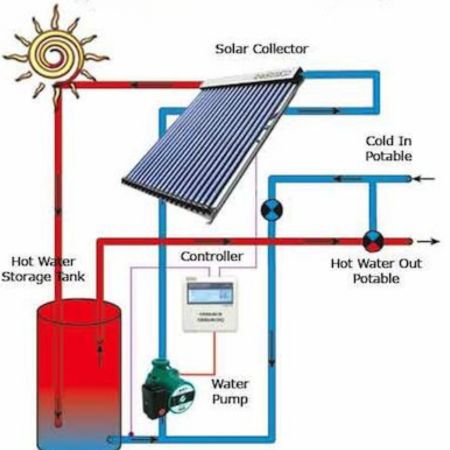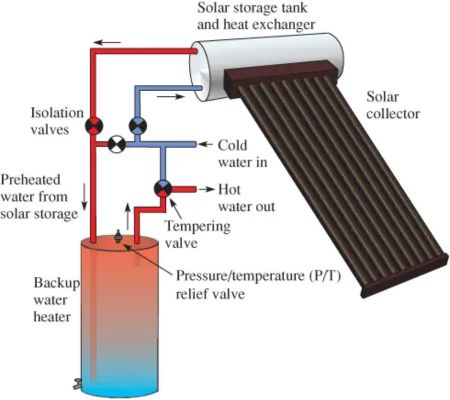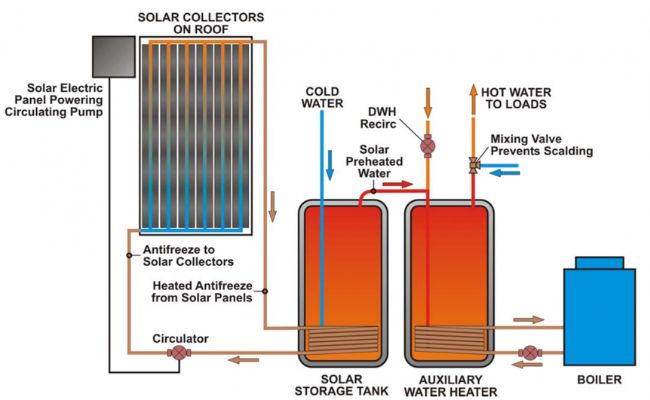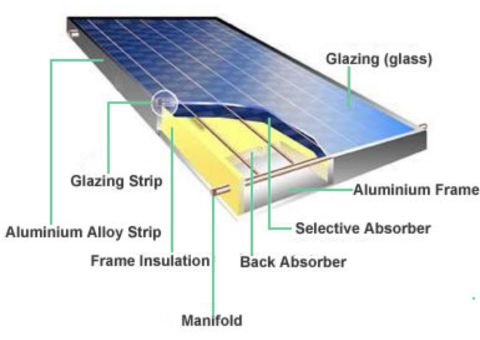Solar water heaters are a great alternative to other water heating systems as they are environment-friendly. Nonetheless, there are certain issues that may limit their performance. It is therefore important to know the common problems with solar water heater systems and how to handle them when they happen.
Troubleshooting Common Solar Water Heater Problems

In this section, we are going to discuss how to troubleshoot common solar water heater problems:
1. Common Problems with Solar Water Heater
Solar Panel Capacity Issues
The solar panel may be unable to produce sufficient power needed by the water heating unit. This may happen due to shadows by trees around, overheating of the modules or moisture entering the circuits.
You can inspect this by using a multimeter to check the voltage drop or checking for discoloration of the modules. You may need to adjust the position of your solar panel to ensure it captures more sunlight or replace any damaged modules.
Failing Of Heat Conducting Rods
It is the work of the conducting rods to transfer the power collected by the collectors to the water heating unit. These rods may fail to function properly if used repeatedly for a long time or misaligned. You can check for this by noting the color of the rods for discoloration. Replace the lines if faulty or adjust their positions.
Heat Pump Issues
The heat pump may be in poor condition due to cloggage by sediments over time. The pump’s impeller or funnel may also be in poor state and may stop functioning efficiently as a result.
You should frequently examine the heat pump for any sediments and the condition of the funnel and impeller. You may need to clean your tank or replace your heat pump to resolve this.
Water Heater Leaks
Water may leak from the water tanks due to the presence of damaged pipes, valves or a corroded water tank. You need to inspect your water heater tank regularly to detect any leakage at an early stage and prevent further damage. You can correct this by replacing any damaged pipes or the tank altogether
Rust-Colored Water
Over time the metallic parts of the water heater may corrode causing discoloration of the water in the tank. It could also be an indication that the sacrificial anode in the water heating unit is not operating efficiently.
You therefore have to regularly check your water heating unit for any rust. You can solve this by replacing the sacrificial metal rod or any other rusted part of the heater.
Noisy Solar Water Heater
Unusual noises from your solar water heater may be a sign of excess pressure in the system resulting in air getting trapped. The noise may also be as a result of buildup of sediments over time. You can solve this by properly bleeding the system or removing water from the tank and cleaning it.
Low Water Pressure
The water may be unable to flow as desired due to damaged parts, use of pipes with a small diameter or faults in the pressure regulator. The valves may also not be able to fully open due to deposits of sediments over time.
You can solve this by embracing the use of pipes with slightly larger diameters, replacing any damaged parts and cleaning the tank.
Smelly Hot Water
Foul odors in your water is an indication of bacteria. Bacteria may grow in your water tank if the sacrificial anode responsible for killing it does not function properly.
You can raise the temperatures to kill the bacteria. You can also flash the water in the tank and use a disinfectant to clean. You may also need to replace the anode rod if damaged.

2. Solar Water Heater Temperature Issues
No Hot Water
The water heating unit may fail to heat the water due to insufficient power from the solar panel, faults in the thermostat or the heating element. You can use a multimeter to check for a short circuit or an open circuit in the heating element.
In case of a fault, replace the components accordingly. You may also need to move your solar panel so that it is exposed to more sunlight.
Insufficient Hot Water
Your water heating unit may fail to provide you with a continuous flow of hot water. If you notice that the water is only hot for a short time, you should check that your thermostat is set to function as desired. You may also need to replace your water tank and install a bigger one.
Water Extremely Cold or Hot
The water flowing through your shower may be too cold or extremely hot. The thermostat is responsible for adjusting the temperatures of the water. A fault in the thermostat may cause overheating of the water heating element making the water too hot. You need to adjust the settings on your thermostat or replace the water heating element if it is faulty.
3. Solar Water Heater Freezing
Freezing is a common solar water heater problem in areas where temperatures drop below 6 degrees Celsius. Therefore, systems having liquid-to-liquid heater exchangers need freeze protection applying these two techniques:
Use Antifreeze Solution
Replace the heat-transfer fluid with an antifreeze solution, usually propylene glycol, and ensure to maintain correct antifreeze concentration. Note that antifreeze fluids deteriorate with time and needs to be replaced every 3 to 5 years.

Drain the Piping and Collector
Normally, a controller in the solar water heater systems helps draining the collector coil automatically. Installed sensors on the storage tank and collector signal the regulator when to deactivate the circulation pump to facilitate collector coil draining.
Using poor-quality or incorrect positioning of the sensors can make them fail to recognize freezing conditions, which can cause costly freeze damage. Ensure that the freeze sensors installation is done based on the manufacturer’s guidelines, and confirm that the controller is functioning properly at least annually.
Also, install an insulated air vent at the topmost section of the collector coil to prevent vacuum formation, ensuring that collector drains completely. Furthermore, ensure that there is no airflow obstruction in the solar water heating system during active drain cycle.
Proper slope of the piping and collectors is vital in facilitating completing draining of water. Make sure that the slope of all piping and collectors should be at least 0.25 inches/foot.
4. Preventing Corrosion and Scaling
Corrosion and scaling are the two primary elements that impact operation of well sited and mounted solar water heater systems.
Corrosion (Air and Hydronic Systems)
There is negligible corrosion in correctly-designed solar water heaters. However, they can experience galvanic corrosion, an electrolytic process as a result of two nonidentical metals touching each other. Therefore, join the steel tank and copper pipe using a bi-metallic connector with plastic sleeve for isolating the two different metals.
Any steel or iron component of open coil hydronic solar water heaters can experience rusting due to oxygen presence. For that matter, use glass or plastic-layered storage tanks, and piping loop made of bronze, stainless steel, brass, copper, rubber, or plastic.
Scaling (Hydronic Systems)
Water with high mineral constituent may result in scaling or accumulation of mineral sediments on the surface of heat transfer system. Scaling lowers the solar water heater system efficiency in many ways, and it can happen in the heat exchanger, distribution pipes and collector. The phenomenon can also lead to pump and valve breakdown.
Troubleshooting this solar water heating problem involves applying water softeners or flowing mild acidic solution across the system every 3 to 5 years. Cleaning the surfaces of the heat exchanger may also be necessary.
Periodic Solar Water Heater Maintenance Checklist
Here are a few solar water heater maintenance guidelines to ensure efficient performance at all times. Also look through the user’s manual for recommended maintenance routine and monitor earlier maintenance works.
1. Collector Shading
Visually inspect if there is any shading of the solar collectors throughout the day on a yearly basis. Shading due to new adjacent building or vegetation growth can significantly impact their performance.
2. Collector soiling
You will not attain optimal collectors’ performance if they are soiled or dusty. This is why routine cleaning is necessary if the area receives inadequate rainfall to wash the soiling off.
3. Collector Seals and Glazing
Confirm if the collector seals are in perfect state, and check whether the glazing is cracked or not. Replacing plastic glazing may be necessary in case they are exceedingly yellowed.

4. Wiring, Duct and Piping Insulation
Confirm and ensure that all the valves are functioning properly. Also, inspect for any deterioration or damage of insulation over wiring, duct and piping. Encase the pipe insulation using protective aluminum or plastic covering and substitute if need be. Moreover, make sure that the wiring duct is protected.
5. Wiring, Ductwork and Plumbing Joints
Inspect duct joints and seals and check the pipe joints for any fluid leaks. Sealing of the ducts should be done using a mastic compound, and all wiring joints need to be tight.
6. Heat Transfer Fluids
There is need to carry out periodic replacement of the antifreeze solution employed in hydronic solar water heater systems. Replace the fluid if its freeze point and pH does not match specification. This is an operation that should be carried out by a professional.
You may also need to eliminate mineral sediments inside the collectors. This is achieved by flowing mild acidic or de-scaling solution across the system after every few years.
7. Controls
The controls of solar water heater systems feature two temperature sensors. One is situated at the base of the storage tank and the other at the outlet of solar collector.
It also has delta-T controller whose purpose is to power on the pump if the solar collector has higher temperature compared to the tank. Similar, the controller shuts the pump down when the collector is not hot enough.
In case the pump is operating at night, the probably causes could be an open circuit in the tank sensor or circuit in the collector sensor. On the other hand, the reverse might be the situation in case the pump is not functioning during the day. To know the sensor that has broken down, compare their resistance to the reference value.
The temperature sensors detaching from the surface they should be measuring is a common solar water heater problem. You solve this issue by fixing them using a stainless steel clamp or lug.
8. Storage Systems
Inspect storage tanks for symptoms of corrosion, rust, leakages, cracks, or other forms of deterioration. There is a sacrificial anode that normally erodes before the steel tank, which needs to be substituted at a span approved by the manufacturer. Furthermore, you ought to flush the tanks regularly to eliminate sediments.
9. Support Structures
Make sure that all bolts and nuts fastening the solar collectors to its support structures are tight enough. Wipe and paint any corroded steel parts if need be.
10. Roof Penetrations
Check for any indications of water leaks on the roof’s undersurface. Preserve sealant and flashing throughout the roof penetrations as necessary.
11. Dampers
Ensure correct placement of dampers in air solar water heaters, and that they open and shut correctly.
12. Pressure Relief Valve
Activate the lever of liquid solar water heater systems to ensure proper functioning of the valve.
13. Blowers or Pumps
Inspect if the blowers or pumps are functioning efficiently. Observe to check whether they power on or not when there is sunshine.
When there is no indication of operation, the blower or pump may have broken down or the controller. Normally, solar water heater problem is solved by replacing the starting capacitor, and not the motor or pump.
When To Call an Expert Plumber
Professional plumbers can assist you resolve these common problems with solar water heaters in house or business premise. You can also seek their service for repair and maintenance of solar water heater systems. You should particularly consult an expert when this solar water heater troubleshooting guide appears overwhelming or you lack the time.
At Ensun, we offer free consultations to ensure all your solar water heating systems operate optimally – talk to out technicians now.


